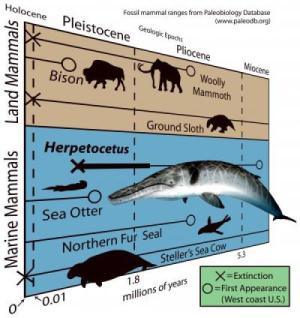Research from New Zealand’s University of Otago detailing the fossil of a dwarf baleen whale from Northern California reveals that it avoided extinction far longer than previously thought.
Otago Department of Geology PhD student Robert Boessenecker has found that the fossil of the 4-5 meter long Herpetocetus, thought to be the last survivor of the primitive baleen whale family called cetotheres, may be as young as 700,000 years old.
Mr Boessenecker says the previously youngest-known fossils of this whale were from the pre-Ice Age Pliocene epoch; approximately 3 million years ago, a time before many modern marine mammals appeared. Baleen whales of this type were most common much earlier, about 10-15 million years ago.

Research detailing the fossil of a dwarf baleen whale, Herpetocetus, from Northern California reveals that it avoided extinction far longer than previously thought. The 4-5 metre long whale, thought to be the last survivor of the primitive baleen whale family called cetotheres, may be as young as 700,000 years old. The previously youngest-known fossils of this whale were from the pre-Ice Age Pliocene epoch; approximately 3 million years ago, a time before many modern marine mammals appeared. Baleen whales of this type were most common much earlier, about 10-15 million years ago. This graphic shows the geologic ages of Herpetocetus and various well known marine and land mammals from California, with a life restoration of Herpetocetus. (Credit: R.W. Boessenecker)
“That this whale survived the great climatic and ecological upheavals of the Ice Age and almost into the modern era is very surprising as nearly all fossil marine mammals found after the end of the Pliocene appear identical to modern species.
“Other baleen whales underwent extreme body size increases in response to the new environment, but this dwarf whale must have still had a niche to inhabit which has only recently disappeared,” he says.
The find indicates that the emergence of the modern marine mammals during the Ice Age may have happened more gradually than currently thought, he says.
The discovery also lends indirect support to a hypothesis about the modern pygmy right whale (Caperea marginata) recently published by Mr Boessenecker’s colleagues Professor Ewan Fordyce and Dr Felix Marx. The pair posited that this enigmatic Southern Ocean whale is not a true right whale but actually a member of the cetothere family and one of the closest relatives of Herpetocetus.
“If their hypothesis is correct, this latest discovery indicates that other close relatives of the pygmy right whale nearly survived to modern times within the Northern Hemisphere.
“In this light, Herpetocetus can be viewed as a Northern Hemisphere equivalent of the pygmy right whale: both are small-bodied with peculiar anatomy, possibly closely related, with feeding habits that are seemingly divergent from other baleen whales.”
All baleen whales lack teeth and instead use baleen to strain small prey like krill and fish from seawater. Many whales, such as humpback and blue whales, gulp enormous amounts of water during lunges, while others such as gray whales filter prey from mud on the seafloor.
Owing to a strange jaw joint, Herpetocetus could not open its mouth more than 35 degrees, unlike any modern baleen whale.



 April 6th, 2013
April 6th, 2013  Riffin
Riffin  Posted in
Posted in  Tags:
Tags: 